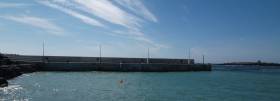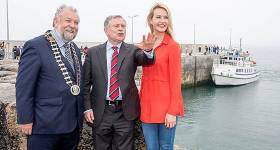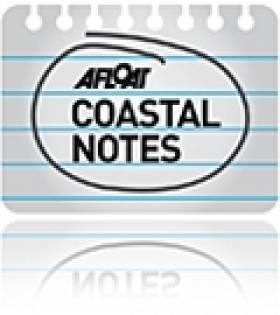Displaying items by tag: Doolin Pier
Doolin Pier's Cabin ‘Hardly Equivalent of Erecting Eiffel Tower’
#TicketIssue - Later this week a High Court judge will decide if he should ban the sale of ferry-ride tickets from a new portable building office at Doolin Harbour, despite the fact they can be sold lawfully from a folding table right beside it.
The Irish Examiner writes that James Connolly, for Clare County Council, told Mr Justice David Keane the provision on the pier of an “unauthorised ultra-cabin structure” was a matter of great concern which was protecting the public interest through the planning regulations.
Mr Connolly said selling tickets from a folding table in the open air, did not require planning permission as did the use of the ultra cabin, purportedly a replacement for an old, unoccupied, derelict and long unused structure on the Doolin pier at Ballaghaline.
The county council seeks an injunction immediately restraining ticket sales from the new cabin and, ultimately at a full trial, will seek its removal.
For much more the newspaper has a report here.
Doolin Pier Wins National Award
The new Doolin Pier development has won the prestigious Irish Concrete Society Award for Infrastructural Projects delivered during 2015.
The award was presented this week to Clare County Council, the contractor L & M Keating Ltd; consulting engineers Punch Consulting, Malachy Walsh & Partners and the main material suppliers for the €6m project, namely Banagher Precast Concrete, Cairealacht Chill-Bhride Teo, Ryan Bros. (Ennis) and McGrath's Quarry.
Among the other shortlisted projects which competed for the Infrastructure Award were the Corrib Tunnel Infill in Co Mayo, the Cloghran AIS Substation in Dublin, Dublin Airport Concrete Apron, Carrigtwohill Wastewater Treatment Plant in Cork and Bridge Projects in Donegal, Sligo and Tyrone.
In its citation for Doolin Pier, the Jury in the 2016 Irish Concrete Society award scheme stated, "This exposed maritime site provided a significant challenge in constructability and in complying with environmental constraints. Concrete is an obvious choice for this structure in this exposed location, combining strength and durability. The innovative step was to use precast construction techniques to construct large fully interlocking sections off site. This reduced the on-site construction time, limiting difficult working conditions and allowing better quality control for the elements which were to be submerged or below the high water line. The overall quality of finish of the in-situ above water deck and wave wall is good, and precast concrete was also very successfully used for wave dissipating x-blocs."
The new pier was officially opened in June 2015 in the North Clare coastal village where currently an estimated 70,000 to 90,000 passengers are carried to and from the Aran Islands by Doolin-based ferry operators and this is expanding annually with the introduction of the Wild Atlantic Way.
Meanwhile, Clare County Council this week announced the appointment of consultants for the design of proposed shoreline facilities at the pier, including a new visitor facility.
The Council says the proposed visitor facility will replace existing temporary structures and will be part of a masterplan proposal relating to the development of the Doolin Pier area including the pier area in general, its interactivity with Doolin village with a significant emphasis on accessibility, parking and traffic management.
The architect-led design team comprises Bucholz McEvoy Architects (Architects), Punch Consulting Engineers (Civil Structural Engineers), IN2 Engineering (M&E Engineers), Aecom (Quantity Surveyor), Aegis Safety Ltd (PSDP safety) and HRA Planning (Planning).
New Doolin Pier Officially Opened In County Clare
#doolinpier – The new €6m Pier at Doolin, Co. Clare, has been officially opened today by Brendan Howlin, T.D., Minister for Public Expenditure & Public Reform.
The new 65-metre pier, the development of which was led by Clare County Council, will serve as a primary access point to and from the Aran Islands for ferry companies operating out of Doolin.
"This important infrastructure project has been long sought after by ferry operators, fishermen and tourists who use the pier. The new pier development will boost visitor numbers in Clare considering access to the Aran Islands from the County has now been greatly enhanced with the completion of this project," said Cllr. John Crowe, Cathaoirleach of Clare County Council.
"I want to congratulate the staff of Clare County Council and the consulting engineers on the project, Punch Consultant Engineers and Malachy Walsh & Partners, who have guided the pier project through the various stages of planning and construction. I also want to acknowledge L & M Keating Limited of Kilmihil who completed the construction of the new pier on schedule and within budget," he added.
Tom Coughlan, Chief Executive, Clare County Council commented: "From the outset, the Council has believed this project would have significant, positive economic and social consequences for the people of North Clare and the wider region, including the Doolin Coast Guard, fishermen, tourists and the general public in terms of leisure and amenity use. This belief has been strengthened over the years as a result of the support shown by the local community, the Elected Members and of course, the Government."
Mr. Coughlan said the completion of the new pier complements plans to develop a Visitor Services facility at the location.
"The next step in the development of Doolin Pier will be the planning and construction of ferry terminal visitor facilities, incorporating improvements to parking and ancillary services. That project is currently being progressed and I look forward to further announcements in the near future," added Mr. Coughlan.
Doolin Pier Visitor Facility & Masterplan Announced
#doolin – Clare County Council has announced plans to develop a Visitor Services facility at Doolin Pier as part of an overall masterplan for the development of shoreline facilities in the County Clare coastal village.
The Council says the proposed facility will replace existing temporary structures and will be part of a masterplan relating to the development of the Doolin Pier area including the pier area in general, vehicle routes to and from Doolin village, and parking and traffic management.
Among the functions and operations considered within the overall plan will be sale of tickets by a number of Ferry Operators, the serving of food, and the provision of toilet facilities for patrons and staff, public waiting area, luggage holding area, tourism information, car/bike parking, waste management, harbour master office and health & safety requirements.
A new €6m pier is currently under construction and is nearing completion, according to the Council. The project is on target for completion by mid-2015. An estimated 70,000 to 90,000 passengers are carried annually by Doolin-based ferry operators.
"I welcome the steps being taken by Clare County Council to develop a visitor facility at Doolin which has been long sought after by users of the pier," stated Cllr. John Crowe, Cathaoirleach of Clare County Council.
"Once completed this summer, I have no doubt that the pier will help to drive ferry activity between North Clare and the Aran Islands and the Cliffs of Moher during the tourist season, as well as accommodate other activities – both leisure based and otherwise. It is important that such significant transport infrastructure is complemented by important ancillary services and facilities as proposed in this masterplan," said Cllr. Crowe.
Clare County Council is presently undertaking a tender process to appoint a Design consultancy team to design the masterplan for the Doolin Pier area.
"Doolin Pier is a gateway to the Aran Islands and is a major economic location in the North Clare area. The investment in the new pier will increase visitor numbers to the North Clare area and it is important therefore, that the necessary services are in place to accommodate this growth," Tom Coughlan, Chief Executive, Clare County Council.
Mr. Coughlan noted that the Visitor Services facility is the priority element of the brief, to be delivered initially as a "sustainable standalone project" capable of future integration within the overall masterplan.
"As part of the service provision by the successfully appointed design team, a full design brief will be developed through design research and via a consultation process. It is anticipated that the new development will enhance visitor numbers to Doolin and the Aran Islands by facilitating easier and more ordered parking, ticket sales and pier operations. This is all part of the Council's major commitment to providing improved infrastructure and services at Doolin Pier," said Mr. Coughlan.
#DoolinPier – A new Atlantic seaboard pier sought by ferry operators and fishermen at Doolin in County Clare is expected to be completed by mid-2015 following the signing of a major marine infrastructural project today.
Brendan Howlin, T.D., Minister for Public Expenditure and Reform was in Doolin this afternoon to visit the location of the proposed €6m pier project for the County Clare coastal village.
Minister Howlin's visit coincided with the signing by Clare County Council of a contract with L&M Keating, the successful tenderer for the construction of the new pier. Construction work will begin in the coming days and is expected to be completed by mid-2015.
Mayor of Clare Cllr. Joe Arkins commented: "This project has been long sought after by ferry operators, fishermen and tourists who use the pier. The new pier development will boost visitor numbers in Clare considering access to the Aran Islands from the County will be greatly enhanced once the project is completed."
He added: "The completed pier will be used mainly to facilitate ferry activity between North Clare and the Aran Islands and the Cliffs of Moher during the tourist season while the existing pier will be available to accommodate other activities – both leisure based and otherwise. The new pier will ensure that Doolin is accessible in all tidal conditions, which will be of particular benefit to Doolin Search and Rescue as well as the ferry operators."
"I want to congratulate Clare County Council and its consultants who have worked closely with interested parties in ensuring that the completed pier brings a wide range of benefits to its users and the wider community," said Mayor Arkins.
Tom Coughlan, Clare County Manager added: "I am delighted that construction of this vitally important piece of infrastructure will commence shortly following years of open debate and extensive consultation with users of the pier, as well as the local community."
He continued: "The Local Authority has invested considerable time and resources into ensuring that the Doolin Pier project is one that benefits all users of the existing pier. Once completed, this project will have significant, positive economic and social consequences for the people of North Clare and the wider region. For example, the construction phase of the project will create jobs as will the increase in business that will arise as a result of the Pier's completion."
Tom Tiernan, Senior Engineer and Doolin Pier Project Manager stated: "I wish to pay tribute to the Council Consultants, led initially by Malachy Walsh and Partners, who guided the project from its inception through the various stages of planning, including the preparation of the Environmental Impact Statement (EIS) which facilitated An Bord Pleanala's decision in 2013 to give the go ahead for the construction of a new pier. I also want to thank Punch Consulting, who are leading the project through its tender and construction stages."
"The next stage of the Pier project is construction which will get underway almost immediately. L & M Keating Ltd, with whom Clare County Council signed a contract with today, is a well established Marine Works contractor and we look forward to working with the company. We anticipate that the project will be completed around mid 2015," concluded Mr. Tiernan.
Doolin Pier Gets Green Light from An Bord Pleanala
#doolinpier – Clare County Council today (Wednesday, 6 March 2013) welcomed the announcement by An Bord Pleanala of its decision to give the go ahead for the construction of a new pier in the North Clare coastal village of Doolin.
The Council said it has reviewed the terms of the Bord's decision and will be meeting the project consultants with a view to commencing the tendering process in the near future.
Reacting to today's announcement, Mayor of Clare Councillor Pat Daly said: "I am delighted that the green light has finally been given for this vitally important piece of infrastructure following years of open debate and discussion on what the best way forward should be. I wish to compliment Clare County Council and its officials for facilitating the process and ensuring that everyone's voice was heard. The Pier will bring increasing numbers of people to County Clare considering access to the Aran Islands from the County will be greatly enhanced once the project is completed."
Tom Coughlan, Clare County Manager said An Bord Pleanala's decision today was "the result of a comprehensive proposal submitted by the Council and extensive consultation with users of the pier as well as the local community."
He continued: "Clare County Council has invested considerable time and resources into ensuring that the Doolin Pier project is one that benefits all users of the existing pier. Once completed, this project will have significant, positive economic and social consequences for the people of North Clare and the wider region. For example, the construction phase of the project will create jobs as will the increase in business that will arise as a result of the Pier's completion."
Tom Tiernan, Senior Engineer and Doolin Pier Project Manager commented: "I wish to pay tribute to the Council Consultants, led by Malachy Walsh and Partners, who have guided the project from its inception through the various stages of planning, including the preparation of the Environmental Impact Statement (EIS) which ultimately facilitated An Bord Pleanala's decision today."
"He added: "The provision of this new pier will have a hugely positive impact on the operations of Ferry operators, fishermen and the local search and rescue unit, who have been finding it increasingly difficult to launch their boats at low water levels."
"The next stage of the Pier project is construction. We will shortly be meeting with the project consultants with a view to getting a tender process underway as soon as possible. We anticipate that the project will be completed during early 2015," concluded Mr. Tiernan.
Ferry Runs Aground off Doolin for Three Hours
According to ferry operator Kevin O'Brien, there were no passengers on board at the time and the vessel got under way again when it was lifted from the rocks with the tide. Mr O'Brien added "this was a very minor incident and there was no damage to the ferry. Doolin is tidal so these things do happen. Even a few inches of water can make a difference".
The Irish Coast Guard was notified of the incident at midday, and its marine rescue co-ordination centre in Dublin requested that members of the local Coast Guard unit board the vessel to assess if there was a pollution risk.
Doolin Coast Guard personnel carried out an inspection and confirmed the ferry had not been damaged and there was no risk of pollution. At about 2.15pm the ferry got under way again with the tide. The company was able to operate services to and from the Aran Islands with its second vessel.



































































